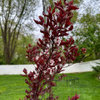Although we are in the dog days of summer, I'm already planning for next winter. At current count, I have 24 western trailing blackberry or hybrid blackberry plants in the ground, most of which are mature. My expectations have been low for their productivity due to my climate being too cold to leave them uncovered. The last two winters have been especially punishing, leaving a large percentage of the canes damaged and unable to produce fruit the following season. I'm not complaining...I went into this understanding the challenge.
Well, I want to raise the bar and find a way to build a low-cost, heated tunnel to protect the plants during the winter. I need to move three more plants to have all of the trailing blackberries in three contiguous plantings, which should make it easier to cover and heat for the winter. All plants will be in 2x2ft raised planters at 6" or 8" height.
My plan is to use 4 or 6 mil plastic sheeting to cover the three sections and then seal them to retain the heat. I have been reading up on heating cables and think they might produce enough heat to meet my heating goals. Ideally, I would like to keep the plants in a temperature range between 20F and 40F during the months of December through mid-March. The temperature could fall into the mid-teens once the plants are dormant but that would be the low end of my temperature tolerance. In addition to the heating cables and plastic sheeting, I need to find a temperature sensor that would help automate the turning on and off of the heating cable. One additional idea to normalize the heat distribution would be to use a long metal pipe and fill it with water and cap it on both ends. By attaching the heating cable to the water-filled pipe, the water in the pipe may hold the heat longer than the air around it, thus allowing a more gradual cooling period.
As far as a structure to support the plastic sheeting, I have a cable support structure in mind that should hold up under the weight of snow and wind.
Does anyone have any suggestions for the type of heating cable or temperature sensor I could use? I plan on running 120AC down to the patch to power the heating cables.







Charles Griebell
inkfin
Related Discussions
Blackberry Dormancy Period
Q
Western (trailing) blackberry report 2013
Q
has anyone attempted winter-protecting tender trailing berries?
Q
Sweltering heat may enhance spread of RRD.(long)
Q
jtburtonOriginal Author
Charles Griebell
jtburtonOriginal Author